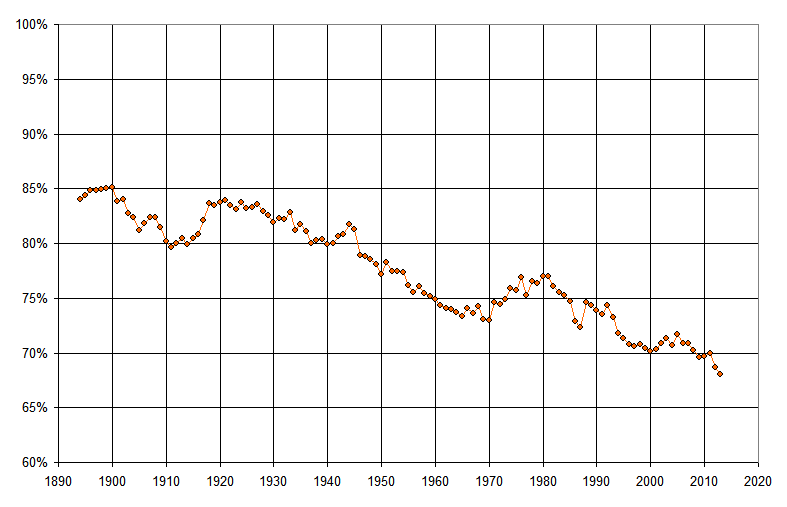Here’s a plot showing the percentage of balls in play each year. Specifically, this refers to the fraction of plate appearances that result in a ball being handled by the defense.
The formula uses at-bats in the numerator, subtracting out home runs and strikeouts, and adding sacrifice hits and sacrifice flies. That total is then divided by plate appearances, which of course includes walks and hit-by-pitch.
As you can see, 2013 is on pace to have the lowest percentage of balls put in play in MLB history. And even though 2013 is far from over and could change, 2012 itself set the all-time record, at just 68.7%.
The two biggest factors are, of course, home runs and strikeouts. Even in this year of very low offense, home runs are still quite high. I wrote about that in my USA Today Sports Weekly piece this week. Strikeouts continue to go higher and higher, and drive the percentage of balls in play lower and lower.
Some comments and implications about the above graph:
- Think about 2013, at 68%, vs baseball in the 1940’s, around 80%. With teams averaging around 38 plate appearances per game, that’s a difference of nearly 5 balls in play per game. Think about that–5 batted balls fewer per game, every game! That’s astounding.
- The fewer balls in play also means that defense matters less. In the current game, defense is the best it’s ever been. Equipment and fields are of uniformly excellent quality and players have better range than ever. However, the lack of balls being put into play means that the defense has fewer chances, so overall, there is less variability on defense from team to team.
- We think of 1968 as the year of the pitcher, but 74.2% of balls were still put in play that year, meaning the defense played a much bigger role.
- Take a look at fielding metrics over the years, here. Putouts have remained the same over the years, because they are basically all outs. But total chances has dropped gradually over the years, from about 41 in the 1920s to 39 in the 1940s to about 37.5 in recent years. This number has fallen a bit because errors have continually dropped, but more because assists have dropped. And why have assists dropped? Because a higher fraction of putouts are to the catcher, i.e. strikeouts, when there can be no assist.
The game is changing, for sure…

